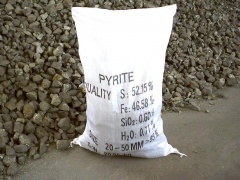Pyrite
| Infobox on Pyrite | |
|---|---|
| Example of Pyrite |  |
| Facts | |
| Origin | - |
| Stowage factor (in m3/t) | 0,33 to 0,50 m3m/t |
| Humidity / moisture | 0% to 7% |
| Ventilation | No special requirements |
| Risk factors | See text |
Pyrite
Description / application
Pyrite is the classic "Fool's Gold". There are other shiny brassy yellow minerals, but pyrite is by far the most common and the most often mistaken for gold. Whether it is the golden look or something else, pyrite is a favourite among rock collectors. It can have a beautiful luster and interesting crystals. It is so common in the earth's crust that it is found in almost every possible environment, hence it has a vast number of forms and varieties.
Bravoite is the name given to a nickel-rich iron sulfide. It is closely related to pyrite but contains up to 20% nickel. Some mineral books treat it as a variety of pyrite.
Pyrite is a polymorph of marcasite, which means that it has the same chemistry, FeS2, as marcasite; but a different structure and therefore different symmetry and crystal shapes. Pyrite is difficult to distinguish from marcasite when a lack of clear indicators exists.
Pyrite's structure is analogous to galena's structure with a formula of PbS. Galena though has a higher symmetry. The difference between the two structures is that the single sulfur of galena is replaced by a pair of sulfurs in pyrite. The sulfur pair are covalently bonded together in essentially an elemental bond. This pair disrupts the four fold symmetry that a single atom of sulfur would have preserved and thus gives pyrite a lower symmetry than galena.
Although pyrite is common and contains a high percentage of iron, it has never been used as a significant source of iron. Iron oxides such as hematite and magnetite, are the primary iron ores. Pyrite is not as ecomonical as these ores possibly due to their tendency to form larger concentrations of more easily mined material. Pyrite would be a potential source of iron if these ores should become scarce.
Pyrite has been mined for its sulfur content though. During WWII, sulfur was in demand as a strategic chemical and North American native sulfur mines were drying up. A sulfide deposit near Ducktown Tenn. was found to be able to mine pyrite and other sulfides such as pyrrhotite and pentlandite and produce the needed sulfur as well as iron and other metals. The sulfur was used in the production of sulfuric acid, an important chemical for industrial purposes. Now most sulfur production comes from H2S gas recovered from natural gas wells.
See also Minerals
Shipment / Storage / Risk factors
This cargo is non-combustible or has a low fire-risk. Extremely dusty. Appropriate precautions shall be taken to protect machinery from the dust of the cargo.
Loading: trim in accordance with the relevant provisions required under the applicable sections of the IMSBC Code (International Maritime Sold Bulk Cargoes Code).
The most widely-known cargoes of this type are mineral concentrates, although many other cargoes can also liquefy, such as fluorspar, certain grades of coal, pyrites, millscale, sinter/pellet feed, etc. Of particular concern is the large number of cargoes of nickel ore loaded in Indonesia and the Philippines in respect of which there are doubts as to the accuracy of the shippers' declarations and certificates.
Although they often look dry in appearance at the time of loading, these cargoes contain moisture in the spaces between the particles. During ocean transport, cargoes are exposed to agitation in the form of engine vibrations, ship's motions and wave impact, resulting in compaction of the cargo. The effect of this process can be a transition from a solid state to a viscous fluid state in which all or part of the cargo can flatten to form a fluid surface.
Despite the fact that the IMSBC Code prescribes the testing and certification requirements designed to ensure that cargoes are loaded only if the moisture content is sufficiently low to avoid liquefaction occurring during the voyage, inaccurate declarations and certificates from shippers still appear to be at the heart of the problem.
Also consult the applicable MSDS sheet.











